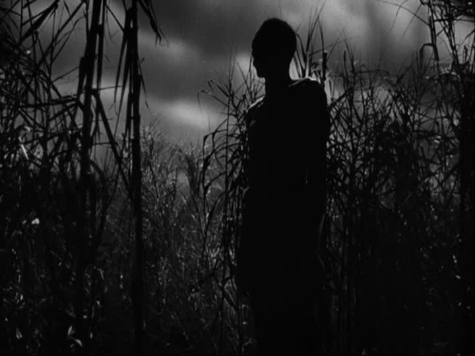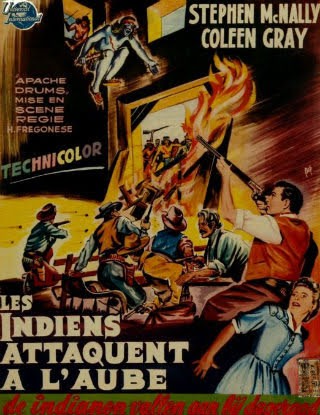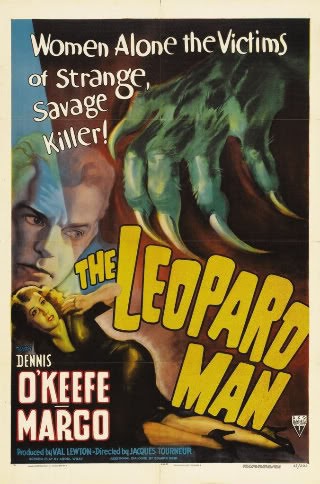Halloween and horror movies have come to complement each other in modern times and I suppose it would be possible to spin out a theory asserting that my Irishness taps into some unconscious yet inescapable atavistic connection to Samhain at this time of year. Still, the truth is that I am not a huge fan of horror as a genre, or perhaps I ought to temper that a little and say that the direction the genre has gone in holds little appeal for me. I can find plenty to enjoy and appreciate in earlier works, starting with the Universal cycle in the 1930s and running right through to the best of Hammer, with detours taking in William Castle’s glib gimmickry and Roger Corman’s raids on Edgar Allan Poe. Right in the middle of those four decades of screen terror can be found the nine marvels of the macabre that producer Val Lewton oversaw at RKO in just four golden years between 1942 and 1946. The Seventh Victim (1943) is as much film noir as anything and if it is to be categorized as horror, then it is of the subtle variety where slow-burning dread and crawling unease reign.
The cinematic world of Val Lewton is one where nothing is quite right, where feeling, moods, and even relationships appear ever so slightly off-kilter. And so it is right from the opening of The Seventh Victim, as the camera pulls back from its close-up on a doom-laden quotation etched into the massive stained glass window flanking the staircase at Highcliffe Academy. As the bell rings and groups of chattering schoolgirls descend those stairs a solitary figure climbs in the opposite direction. This is Mary Gibson (Kim Hunter), already figuratively setting out on a different path. The starchy headmistress inform this young orphan that her fees have been unpaid for some time and, more worrying, her older sister Jacqueline has apparently disappeared in New York. Eschewing the opportunity to work off her fees by tutoring younger pupils, Mary opts instead to head for New York in the hope of finding her missing sibling. She knows that Jacqueline (Jean Brooks) was the owner of a cosmetics outfit but inquiries there leave her with the disconcerting news that she had sold up just before dropping out of sight. The last sighting of her was at an Italian restaurant going by the name of Dante. Can it be a coincidence that an establishment borrowing its name from the author of The Divine Comedy should be located below the street, requiring its patrons to quite literally descend to a lower level? These are the first steps which will lead Mary on a labyrinthine route through the Bohemian world of Greenwich Village and on to the lair of a cult dedicated to evil. This quest for Jacqueline – under the supervision of three pillars of rationalism: Tom Conway’s psychiatrist symbolizing science, the law in the shape of Hugh Beaumont, and the arts as represented by Erford Gage’s poet – may be taken as a quest for the soul itself. Now one could read that as a search for fulfillment amid the cold anonymity of the modern metropolis. Then again it perhaps reflects Jacqueline’s own spiritual journey, one which metaphorically traces Dante’s classic path through sin and penance on the way towards hopefully attaining salvation.
The Seventh Victim saw Mark Robson taking his seat in the director’s chair for the first time. He’d started out as film editor working with Orson Welles and then with Val Lewton before the latter offered him the chance to call the shots. It is an impressive debut feature, unsettling and absorbing in equal measure, raising as many questions as it ultimately answers and benefiting from a well-paced script by Charles O’Neal and DeWitt Bodeen (Cat People, The Curse of the Cat People). Nicholas Musuraca’s peerless cinematography comes to the fore too. Time and again we see his key light picking out the subject, carving some small pool of respite from the deep, inky shadows that forever threaten to encroach and envelop. On a side note, there is a “shower scene” in this movie, a typically creepy and unnerving interlude which I have seen some people suggest might have been an influence on Hitchcock’s Psycho. Frankly, I don’t really buy that theory – the scene not only plays out in a wholly different fashion but it’s aiming for a moody and disconcerting effect as opposed to the raw shock of Hitchcock’s iconic sequence.
Debutante Kim Hunter acts as the point of view character for the audience, an innocent (albeit a steadfast and determined one) cast adrift in the city and forced to confront all the empty indifference which characterizes it. It’s a sympathetic piece of work from the young actress, refraining from a descent into hysterics during tense passages such as the late night incursion into the cosmetics company’s premises and the subsequent ride on the subway; the latter scene, imbued with a helplessly nightmarish quality, is worth the price of admission in itself. Guiding her through this are the puppy-like Hugh Beaumont, Erford Gage’s vaguely fey poet and a quietly authoritative Tom Conway was Dr Louis Judd. Conway played the same character, or at least a character of that name, in the previous year’s Cat People, and certain comments he makes sound like they are referencing that role although Judd appeared to have died in the earlier movie. To be honest, I’m not entirely sure what the timeline involved is, or indeed if there is even supposed to be any actual connection between the films. Anyway, that is not something I attach much importance to. At the center of it all, however, is Jean Brooks as the elusive and enigmatic Jacqueline. She drifts in and out of the picture alternating between nervy panic and listless resignation, a visually striking symbol of existential detachment.
Warner Brothers released The Seventh Victim on DVD as part of a Val Lewton box set many years ago, paired on the same disc with a feature length documentary on the producer’s career. As far as I’m aware, there hasn’t been any upgrade offered since then. While the image is pretty strong as it stands, a Blu-ray would only enhance Musuraca’s evocative cinematography. Bearing in mind the studio has been gradually putting Lewton’s films out in high definition, it can only be a matter of time before The Seventh Victim is afforded the same treatment. For those not entirely sold on the concept of the horror film Val Lewton’s tales of subtle solicitude are highly recommended, at Halloween or any other time of year for that matter.










